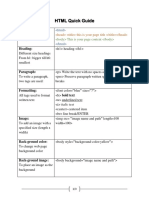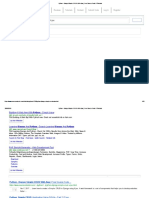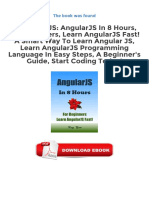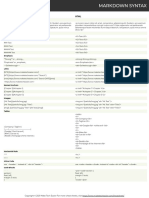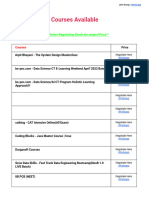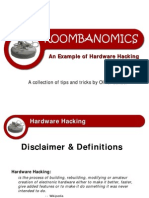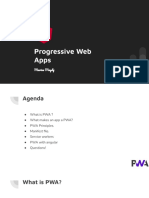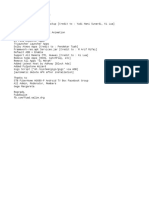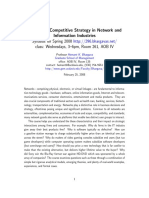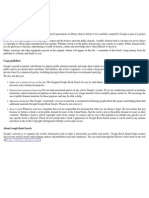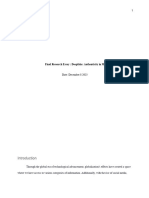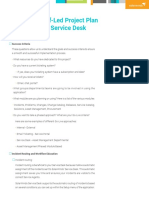THE ULTIMATE
www.bongodev.com
� The Ultimate HTML Cheat Sheet
HTML
Stands for HyperText Markup Language
To create hyperlinks and to markup
contents in the webpage that renders
on the browser
bongoDev bootcamp
www.bongodev.com
� The Ultimate HTML Cheat Sheet
An HTML – document consists of two major parts
1 <!DOCTYPE html> Document type declaration
<html>
2 Root element
</html>
The root element <html> consists of two major parts
<html>
Container/holder to provide
1 <head> </head> information to the browser / SEO
Container/holder for other tags
2 <body> </body> (heading, image, table form,
etc) to render content in the
browser
</html>
bongoDev bootcamp
www.bongodev.com
� The Ultimate HTML Cheat Sheet
<html>, <head>, <body> - are known as tags/elements.
Tags/Elements are the building blocks of an HTML page or
document. We can’t create a Web page without the
tags/elements
This language uses HTML tags to structure web pages, so they
will have a header, body, sidebar, and a footer etc.
It is easy to forget tags and a great solution to have a cheat
sheet in front of you in your difficult moment
"I could either watch it
happen or be a part of it."
Elon Musk
bongoDev bootcamp
www.bongodev.com
� The Ultimate HTML Cheat Sheet
Opening (start)-closing (end)
Vs
Self Closing Tags
Generally, each tag has start/opening and end/closing parts.
The end tag is followed by a forward slash (/) before the tag
name.
Opening (start)-closing (end)
<h1> This is a heading </h1>
start/opening tag end/closing tag
Content – renders in the browser
Example:
<html>, <body>, <h1> to <h6>, <p>, <div>, <form>,
<sup>, <sub>, <ul>, <ol>, <li>, <a>, <strong>, <em>
There are other tags that do not have start or end tag which
Self Closing Tags
are known as self closing tags
Example:
<img> <br>, <link>, <hr>, <input>,
<label>
bongoDev bootcamp
www.bongodev.com
� The Ultimate HTML Cheat Sheet
Block Vs Inline Elements/Tags
Block Elements:
Takes the full width of the device screen and always starts in
a new line
Example:
<div>, <p>, <h1>-<h6>, <form>, <article>, <aside>, <dd>,
<dl>, <dt>, <figcaption, <figure>, <footer>, <header>, <hr>,
<li>, <main>, <nav>, <ol>, <section>, <table>, <tfoot>, <ul>,
<video>, <hr>
Inline Elements:
Takes the required width of the device screen only for its
content
Example:
<a>, <big>,<br>, <button>, <code>, <em>,
<i>, <img>, <input>, <label>, <map>,
<script>, <select>, <small>, <span>,
<strong>, <sub>, <sup>, <textarea>, <time>
bongoDev bootcamp
www.bongodev.com
� The Ultimate HTML Cheat Sheet
It’s better to have a Cheat Sheet in your hand
<html> ….</html>
This tag is the root element of a webpage. It appears at the very first and last line
of the webpage. It is the parent tag or holder for every other tag used on the page.
<head>…. </head>
It consists of metadata about the webpage to provide the website’s
information to google/SEO.
<title> …. </title>
This tag contains the title/name of the webpage. Search engines use this tag to
extract the topic of the webpage to rank relevant search results.
<link/>
Used to link external resources on the page. For example - style sheet,
CDN links, google fonts, script tag etc
<meta/>
This is the metadata tag for the webpage to provide the author, keywords, and
description to the search engine.
<body> …. </body>
It is the container of all tags to render contents in the browser. Everything we
see on the device screen exists inside this tag.
Example:
<html>
<head>
<meta charset="utf-8">
<meta name="viewport" content="width=device-width, initial-
scale=1.0">
<title>My Website</title>
<link rel="stylesheet" href = "style.css">
</head>
<body>
<h1>I’m a heading</h1>
</body>
</html>
bongoDev bootcamp
www.bongodev.com
� The Ultimate HTML Cheat Sheet
<div> …. </div>
Is known as a container and can contain other tags. It is a block
element
<h1 to h6>
There are 6 heading tags available – h1, h2, h3, h4, h5, h6
<h1> has the largest font size, and <h6> has the smallest
<p> … .</p>
Paragraph tag which contains text
<span> …. </span>
Inline element and container of text, icon, image etc
<hr>
It draws a horizontal line across the width of the page
<br>
A line break for elements. Used to create a new line
<strong> … .</strong>
To make text bold
<em> …. .</em>
To make text Italic
<sub> …. </sub>
Used for writing a subscript (smaller font just below the mid-point of
normal font). Example: O2
<sup> … </sup>
Used for writing superscripts. Example: x²
Example
<div>
<h1>I’m a heading</h1>
<p> This is a paragraph
<span>an icon</span> of 20 words </p>
<hr>
<h2>I’m smaller than h1 tag</h2> <br>
<strong>Make me bold</strong>
<em>Make me Italic</em>
bongoDev bootcamp
</div>
www.bongodev.com
� The Ultimate HTML Cheat Sheet
Links / Anchor Tag
<a href=””> …</a>
Known as an Anchor tag. Used for creating hyperlinks
<a href=”#about”> …</a>
To navigate to a specific section (div) of the webpage.
<a href=”mailto:xyg@gmail.com”> …</a>
For sending emails.
Image
<img >
Used to display images on the webpage
Image Attributes:
Key and value separated by equal (=) sign
src=“url”
Relative / absolute path of an image
alt=“text”
The text is useful for SEO and the alt text will appear if the image is broken for
some reason
width=“400px”
Specifies image with in pixels or percentages and keeps aspect ratio
border=“”
Specifies border thickness of an image. Default value is 0. if border not
mentioned
Video
<video src= "relative/absolute path" controls autoplay loop></video>
controls > provide video controllers
autpplay > video starts automatically when webpage loads on the browser
loop > never video stops, keeps playing
Iframe
<iframe> ….</iframe>
An inline block of element, is used as a container to embed media files. It can
contain a webpage, YouTube video, Google map etc.
bongoDev bootcamp
www.bongodev.com
� The Ultimate HTML Cheat Sheet
HTML Lists
<ol> ….</ol>
Renders a list of items/elements in an ordered manner
<ul> ….</ul>
Renders a list of items/elements in an unordered manner. The most commonly used tag to create navbar
or nav list
<li> ….</li>
Represents an item on a list
<dl> ….</dl>
Description list. Used to define description of items. For example grocery item list
<dt> ….</dt>
The definition/name of a single term
<dd> ….</dd>
The description for the item.
Example
<ol>
<li>January</li>
<li>February</li> <dl>
<li>March</li> <dt>Walton</dt>
</ol> <dd> D eshi brand</dd>
<ul>
<dt>Iphone</dt>
<li>Python</li>
<li>Node</li> <dd>Apple product</dd>
<li>JavaScript</li> </dl>
</ul>
Entity
Character entities are used to display reserved characters in HTML. Some characters are
reserved in HTML. If you use the less than (<) or greater than (>) signs in your text, the
browser might mix them with tags. Character entities are used to display reserved
characters in HTML. A character entity looks like this: &entity_name;
To display a less than sign (<) we must write: < or <
The followings are the the commonly used entities:
© ©
® ®
< <
> >
bongoDev bootcamp
www.bongodev.com
� The Ultimate HTML Cheat Sheet
HTML Forms
<form> ….</form>
The parent tag for an HTML form and consists of many input tags or button
action=“url”
The URL is the End Point to pass data to the back endpoint (API)
Method=“POST”
HTTP method ( generally POST ) to submit or post the form data.
<label> …</label>
Used to label a field in the form.
<input >
Is used to take input from the user. The input type is determined by a number of
attributes. It takes different data types, i.e. text, email, password, name, mobile
number, messages and it could be a submit or reset
Form Input Type Attribute
type=””
Determines which type of input (text, email, dates, password) is requested from the user.
Name=””
Specifies the name of the input field.
Value=””
Specifies the value contained in the input field
Required
If the required attribute is added to the input field, it specifies a mandatory field
and value can not be empty. The Form won’t allow you to submit data.
Placeholder=””
Used to give hints to the user about the nature of the input value
disabled
Disables the input element and the user can not input data.
<textarea> …</textarea>
Used for longer strings of input. Used to input message or email body
<select> …</select>
Allows user to choose an option from a list of options
bongoDev bootcamp
www.bongodev.com
� The Ultimate HTML Cheat Sheet
Form Option Attribute
value=””
The visible text for the user for any given option
selected
Determines which option is selected by default when the form loads
<button> …</button>
Tag for creating a button for form submission
Example
<form action="form_submit.php" method="POST">
<fieldset>
<input type="text" name="full_name" placeholder="Your Name" required>
<input type="email" name="email" placeholder="Email”
<input type=”password" name=”password" placeholder=”Password"
<textarea name="message" placeholder=“Your message…………”></textarea>
<input type="submit" value="Submit">
</fieldset>
</form>
Table
<table> …</table>
To create a table in the webpage
<caption> …</caption>
Table title. H1, h2 or h3 tags can be used for table caption
<thead> …</thead>
Contains table header information
<tbody> …</tbody>
Contains table body data information
<tr> …</tr>
Describes a single row in a table.
<th> …</th>
Contains the value of a heading of a table’s column.
<td> …</td>
A single cell of a table. Contains the actual value/data for a particular header.
bongoDev bootcamp
www.bongodev.com
� The Ultimate HTML Cheat Sheet
HTML5 / Semantic Elements
<header> ….</header>
Defines the header of a webpage. It replaced <div> container. Container of the header items
<footer> ….</footer>
Defines the webpage footer. Container of the footer items.
<main>….</main>
Marks the main content of the webpage.Or,webpage body.
<article>….</article>
Used to create blog article
<aside> …</aside>
Defines content displayed as a sidebar of the webpage. Side NavBar or to define side notes
<section>….</section>
Defines a particular section on the webpage. Example: Hero/Showcase section
<figure>….</figure>
A tag reserved for images, and figures (chart, diagram) in HTML5.
<figcaption> ….</figcaption>
A description of the figure is placed below the image or figure.
<nav>….</nav>
To create a Navbar. Navigation links store here for a webpage.
<menuitem>…</menuitem>
A particular item from a list or a menu.
<time>….</time>
Tag for formatting date and time. Usually used to define a blog article published date
bongoDev bootcamp








